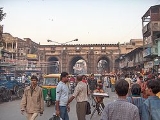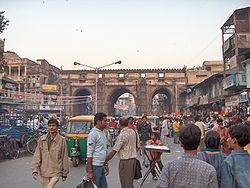
Gujarat Sultanate
Encyclopedia
The Gujarat Sultanate was an independent kingdom established in the early 15th century in Gujarat. The founder of the ruling Muzaffarid dynasty, Zafar Khan (later Muzaffar Shah I) was appointed as governor of Gujarat by Nasir-ud-Din Muhammad bin Tughluq IV in 1391, the ruler of the principal state in north India at the time, the Delhi Sultanate
. Zafar Khan defeated Farhat-ul-Mulk near Anhilwada Patan
and made the city his capital. He declared himself independent in 1407. The next sultan, his grandson Ahmad Shah I founded the new capital Ahmedabad
in 1411 on the banks of Sabarmati River
, which he styled as Shahr-i-Mu'azzam (the great city). The prosperity of the sultanate reached its zenith during the rule of Mahmud Shah I Begada. In 1509, Portuguese wrested Diu from Gujarat sultanate following the Battle of Diu (1509)
. Mughal emperor Humayun attacked Gujarat in 1535. The end of the sultanate came in 1573, when Akbar annexed Gujarat in his empire. Gujarat became a Mughal Subah
. The last ruler Muzaffar Shah III was taken prisoner to Agra. In 1583, he escaped from the prison and with the help of the nobles succeeded to regain the throne for a short period before being defeated by Akbar's general Abdur Rahim Khan-i-Khanan.
appointed Malik Mufarrah, also known as Farhat-ul-Mulk and Rasti Khan governor of Gujarat in 1377. In 1387, Sikandar Khan was sent to replace him, but he was defeated and killed by Farhat-ul-Mulk. In 1391, Sultan Nasir-ud-Din Muhammad bin Tughluq appointed Zafar Khan, the son of Wajih-ul-Mulk as governor of Gujarat and conferred him the title of Muzaffar Khan. In 1392, he defeated Farhat-ul-Mulk in the battle of Kamboi, near Anhilwada Patan and occupied the city of Anhilwada Patan.
In 1403, his son Tatar Khan urged his father to march on Delhi, which he declined. As a result, Tatar imprisoned him and declared himself sultan under the title of Muhammad Shah. He marched towards Delhi, but on the way he was poisoned by his uncle, Shams Khan. After the death of Muhammad Shah, Muzaffar was released from the prison and he took over the control over administration. In 1407, he declared himself as Sultan Muzaffar Shah, took the insignia of royalty and issued coins in his name. After his death in 1411, he was succeeded by his grandson, the son of Tatar Khan, Ahmad Shah.

Soon after his accession, Ahmad Shah was faced with a rebellion of his uncles. The rebellion was led by his eldest uncle Firuz Khan, who declared himself king. Ultimately Firuz and his brothers surrendered to him. During this rebellion Sultan Hoshang Shah of Malwa invaded Gujarat. He was repelled this time but he invaded again in 1417 along with Nasir Khan, the Faruqi dynasty
ruler of Khandesh and occupied Sultanpur and Nandurbar. Gujarat army defeated them and later Ahmad Shah led four expeditions into Malwa in 1419, 1420, 1422 and 1438.
In 1429, Kanha Raja of Jhalawar
with the help of the Bahmani Sultan Ahmad Shah ravaged Nandurbar. But Ahmad Shah's army defeated the Bahmani army and they fled to Daulatabad. The Bahmani Sultan Ahmad Shah sent strong reinforcements and the Khandesh army also joined them. They were again defeated by the Gujarat army. Finally, Ahmad Shah annexed Thana and Mahim from Bahmani kingdom.
At the beginning of his reign, he founded the city of Ahmadabad, where he shifted the capital from Anhilwada Patan. The Jami Masjid (1423) and the Teen Darwaza (Triple Gateway) in Ahmedabad were built during his reign.
Sultan Ahmad Shah died in 1443 and succeeded by his eldest son Muizz-ud-Din Muhammad Shah.
and Champaner
forts. Mahmud died on 23 November 1511.
defeated a joint army of Malwa
and Gujarat sultanates and took Mahmud Shah II of Malwa captive. Muzaffar Shah sent an army to Malwa but their service was not required as Rana Sanga had generously restored Mahmud II to the throne. He died on 5 April 1526 and succeeded by eldest son Sikandar.
Delhi Sultanate
The Delhi Sultanate is a term used to cover five short-lived, Delhi based kingdoms or sultanates, of Turkic origin in medieval India. The sultanates ruled from Delhi between 1206 and 1526, when the last was replaced by the Mughal dynasty...
. Zafar Khan defeated Farhat-ul-Mulk near Anhilwada Patan
Patan, Gujarat
Patan was a capital of Gujarat in medieval times. It is the administrative seat of Patan District in the Indian state of Gujarat and administered by municipality. The city contains many Hindu and Jain temples as well as few mosques, dargahs and rojas...
and made the city his capital. He declared himself independent in 1407. The next sultan, his grandson Ahmad Shah I founded the new capital Ahmedabad
Ahmedabad
Ahmedabad also known as Karnavati is the largest city in Gujarat, India. It is the former capital of Gujarat and is also the judicial capital of Gujarat as the Gujarat High Court has its seat in Ahmedabad...
in 1411 on the banks of Sabarmati River
Sabarmati River
The Sabarmati River is a river in western India and one of the biggest rivers of north Gujarat. River Sabarmati is one of the major West flowing river of Gujarat which originates from Dhebar lake in Aravalli Range of the Udaipur District of Rajasthan and meets the Gulf of Cambay of Arabian Sea...
, which he styled as Shahr-i-Mu'azzam (the great city). The prosperity of the sultanate reached its zenith during the rule of Mahmud Shah I Begada. In 1509, Portuguese wrested Diu from Gujarat sultanate following the Battle of Diu (1509)
Battle of Diu (1509)
The Battle of Diu sometimes referred as the Second Battle of Chaul was a naval battle fought on 3 February 1509 in the Arabian Sea, near the port of Diu, India, between the Portuguese Empire and a joint fleet of the Sultan of Gujarat, the Mamlûk Burji Sultanate of Egypt, the Zamorin of Kozhikode...
. Mughal emperor Humayun attacked Gujarat in 1535. The end of the sultanate came in 1573, when Akbar annexed Gujarat in his empire. Gujarat became a Mughal Subah
Subah
A Subah was a province of the Mughal Empire in South Asia. The governor of a subah was known as a subahdar, which later became subedar to refer to an officer in the Indian Army...
. The last ruler Muzaffar Shah III was taken prisoner to Agra. In 1583, he escaped from the prison and with the help of the nobles succeeded to regain the throne for a short period before being defeated by Akbar's general Abdur Rahim Khan-i-Khanan.
Muzaffar Shah I
Delhi Sultan Firuz Shah TughluqFiruz Shah Tughluq
-External links:*...
appointed Malik Mufarrah, also known as Farhat-ul-Mulk and Rasti Khan governor of Gujarat in 1377. In 1387, Sikandar Khan was sent to replace him, but he was defeated and killed by Farhat-ul-Mulk. In 1391, Sultan Nasir-ud-Din Muhammad bin Tughluq appointed Zafar Khan, the son of Wajih-ul-Mulk as governor of Gujarat and conferred him the title of Muzaffar Khan. In 1392, he defeated Farhat-ul-Mulk in the battle of Kamboi, near Anhilwada Patan and occupied the city of Anhilwada Patan.
In 1403, his son Tatar Khan urged his father to march on Delhi, which he declined. As a result, Tatar imprisoned him and declared himself sultan under the title of Muhammad Shah. He marched towards Delhi, but on the way he was poisoned by his uncle, Shams Khan. After the death of Muhammad Shah, Muzaffar was released from the prison and he took over the control over administration. In 1407, he declared himself as Sultan Muzaffar Shah, took the insignia of royalty and issued coins in his name. After his death in 1411, he was succeeded by his grandson, the son of Tatar Khan, Ahmad Shah.
Ahmad Shah I

Soon after his accession, Ahmad Shah was faced with a rebellion of his uncles. The rebellion was led by his eldest uncle Firuz Khan, who declared himself king. Ultimately Firuz and his brothers surrendered to him. During this rebellion Sultan Hoshang Shah of Malwa invaded Gujarat. He was repelled this time but he invaded again in 1417 along with Nasir Khan, the Faruqi dynasty
Faruqi dynasty
The Faruqi dynasty was the ruling dynasty of the Khandesh sultanate from its inception in 1382 till its annexation by the Mughal emperor Akbar in 1601. The founder of the dynasty, Malik Ahmad participated in a rebellion against the Bahmani ruler Muhmmad Shah I in his early years...
ruler of Khandesh and occupied Sultanpur and Nandurbar. Gujarat army defeated them and later Ahmad Shah led four expeditions into Malwa in 1419, 1420, 1422 and 1438.
In 1429, Kanha Raja of Jhalawar
Jhalawar
Jhalawar is a city in southeastern Rajasthan. It was the capital of the former princely state of Jhalawar, and is the administrative headquarters of Jhalawar District. Jhalawar was once known as Brijnagar .-Jhalawar town:...
with the help of the Bahmani Sultan Ahmad Shah ravaged Nandurbar. But Ahmad Shah's army defeated the Bahmani army and they fled to Daulatabad. The Bahmani Sultan Ahmad Shah sent strong reinforcements and the Khandesh army also joined them. They were again defeated by the Gujarat army. Finally, Ahmad Shah annexed Thana and Mahim from Bahmani kingdom.
At the beginning of his reign, he founded the city of Ahmadabad, where he shifted the capital from Anhilwada Patan. The Jami Masjid (1423) and the Teen Darwaza (Triple Gateway) in Ahmedabad were built during his reign.
Sultan Ahmad Shah died in 1443 and succeeded by his eldest son Muizz-ud-Din Muhammad Shah.
Muhammad Shah I
Muhammad Shah first led a campaign against Idar and forced its ruler, Raja Hari Rai or Bir Rai to submit to his authority. He then exacted tribute from the Rawal of Dungarpur. In 1449, he marched against Champaner, but the ruler of Champaner, Raja Kanak Das, with the help of Malwa Sultan Mahmud Shah Khilji forced him to retreat. On the return journey, he fell seriously ill and died in February, 1451. After his death, he was succeeded by his son Qutb-ud-Din Ahmad Shah II.Mahmud Begadha
After the death of Qutb-ud-Din Ahmad Shah II in 1458, the nobles raised his uncle Daud Khan to the throne. But within a short period of seven or twenty-seven days the nobles deposed him and set on the throne Fath Khan, son of Muhammad Shah II. Fath Khan, on his accession, adopted the title Abu-al Fath Mahmud Shah but he was popularly known as Mahmud Begadha. He received the sobriquet Begadha, which literally means conqueror of two forts, probably after conquering GirnarGirnar
Girnar is a collection of mountains in the Junagadh District of Gujarat, India, situated near Junagadh at a distance of 327 km from Ahmedabad. It is a holy place and an important pilgrimage for both Hindus and Jains. There are a number of temples located here. Amidst the lush green Gir...
and Champaner
Champaner
Champaner चंमपानेर شمبنر is a historical city in the state of Gujarat, in western India. It is located in Panchmahal district, 47 kilometres from the city of Vadodara. The city was briefly the capital of Gujarat....
forts. Mahmud died on 23 November 1511.
Muzaffar Shah II
Khalil Khan, son of Mahmud Beghara succeeded his father with the title Mazaffar Shah. In 1519, Rana SangaRana Sanga
-Historical Fact:Maharana Sangram Singh was the ruler of Mewar state, a region lying within the present-day Indian state of Rajasthan, a desert region, between 1509 and 1527. He was a scion of the Sisodia clan of Suryavanshi Rajputs...
defeated a joint army of Malwa
Malwa Sultanate
The Malwa Sultanate was a late medieval independent kingdom in the Malwa region of the present day Madhya Pradesh state in India in 1392–1562.-History:For earlier history, see article Malwa....
and Gujarat sultanates and took Mahmud Shah II of Malwa captive. Muzaffar Shah sent an army to Malwa but their service was not required as Rana Sanga had generously restored Mahmud II to the throne. He died on 5 April 1526 and succeeded by eldest son Sikandar.

